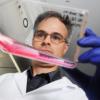
Organ & Tissue Replacement and Regeneration
#91
Posted 14 June 2010 - 03:44 PM
Growing Working Livers:
http://news.bbc.co.u...th/10293842.stm
I think livers are going to be one of the first organs grown in-vitro because it is able to regenerate. I suppose that in the infancy of the science you don't have to grow the whole organ only a part as little as a third of it and then transplant it in-vivo. Then it might be able to regenerate to a fully volume.
Second there is an article about how programmable proteins may be able to treat cancer. At the bottom of the article there are mention a potential application in organ replacement using the nanoswitches.
http://news.bbc.co.u...nt/10297884.stm
I have never heard of the nanoswitches and that it might be a potential application in growing replacement organs.
#92
Posted 30 October 2011 - 03:11 PM
Lung Regeneration Closer to Reality With New Discovery by Weill Cornell Medical College Researchers
Study's Authors Show Blood Vessels Support Lung Regeneration and Their Findings Could Potentially Open the Door to Therapy for Lung Disorders
NEW YORK (Oct. 28, 2011) — Researchers at Weill Cornell Medical College say they have taken an important step forward in their quest to "turn on" lung regeneration — an advance that could effectively treat millions of people suffering from respiratory disorders.
In the Oct. 28 issue of the journal Cell, the research team reports that they have uncovered the biochemical signals in mice that trigger generation of new lung alveoli, the numerous, tiny, grape-like sacs within the lung where oxygen exchange takes place. Specifically, the regenerative signals originate from the specialized endothelial cells that line the interior of blood vessels in the lung...
#93
Posted 30 October 2011 - 04:57 PM
sponsored ad
#94
Posted 30 October 2011 - 11:22 PM
I am going to be very very cynical at this moment and say that the main impediment to regenerating organs in-situ is the U.S. MLB home run record. Follow me here. Instead of focusing on more pressing problems of the day, U.S. senators and congressman seem more interested in sticking their nose into every whiff of performance enhancing substances they can, in some quixotic attempt to make sure the "national pastime" remains pure. Many of the stem cell (and other) growth factors being discovered nowadays are going to fall under their witch hunts, because they are essentially, or at least very analogous to HGH, steroids, and other PEDs. It will be up to us to head them (and the FDA) off at the pass. Again, I am being quite cynical.
#95
Posted 31 October 2011 - 06:01 AM
The scientists found that removal of the left lung activates receptors on lung endothelial cells that respond to vascular endothelial growth factor (VEGF) and basic fibroblast growth factor (FGF-2). Activation of these receptors promotes the rise of another protein, matrix metalloproteinase-14 (MMP14). The researchers discovered that MMP14, by releasing epidermal growth factors (EGF), initiates the generation of new lung tissue.
By activating MMP-14, the lung can regenerate itself. I'm anxious for the study to be published so I can read the full version. An earlier study proposed that activation of the canonical wnt/beta catenin system can do the same. Does MMP-14 have anything to do with the beta catenin system ? It seems like the two pathways are unique and independent of each other so we may have two potential ways to regenerate the lung. We already know that lithium can activate beta catenin very well on its own. I wonder if any substance can induce the specific epidermal growth factors mentioned in that study. I don't think aberrant induction of MMP-14 is a good idea.
#96
Posted 31 October 2011 - 12:08 PM
#97
Posted 31 October 2011 - 07:29 PM
Another consideration for long term rejuvenation of the lung would be the biological age of the transplanted cells. If they are derived from adult stem cells or IPS methods, then would they have shorter telomeres? And thus not last very long in an old patient? Or am I way off here? I suppose getting a better functioning lung, whether or not the cells were biologically old, would be a great bridge to get to the next, more comprehensive level of rejuvenation.
#98
Posted 31 October 2011 - 08:09 PM
#99
Posted 31 October 2011 - 08:24 PM
As far as therapies from this particular discover go, I would say that it will be a long time. 10-15 years wouldn't surprise me, though other developments could speed that up. COPD is a horrible condition, and it's also widespread, so there will be a lot of impetus to move on it. It's certainly not an orphan drug situation. Rather than mess around with MMP14, they'll probably try to develop a small molecule that's stable and has decent pharmacokinetics.I'm interested in finding out more, how long before human trials?
#100
Posted 01 November 2011 - 07:39 AM
I'll be happy to email the full study for anyone who wants it. The dose in rats used was 200 mg/kg. That translates to roughly 13 mg/kg for humans. That still means I would have to take 1.2 grams of elemental lithium everyday for a couple of weeks to fully regenerate the lung.
I revisited this idea again last night. According to this paper though, lithium is not a specific inhibitor of GSK-3, at least in vivo. The 2 micromolar concentration of lithium that is needed to activate beta catenin is also a setback. There are other activators in the nano range but none of which I recognize.
With that said, I still have hope that even small amounts of lithium will do something...
Edited by Lufega, 01 November 2011 - 07:47 AM.
#101
Posted 01 November 2011 - 07:56 AM
Activators of Beta Catenin-----------------
Curcumin activates by suppression of GSK3 ?
cAMP by phosphorylating GSK-3 PMID:
19819952
memantine and choline PMID: 16464655
Riboflavin Activates PMID: 20688149
Lithium chloride activates
SOD activates PMID: 18339714
Forskolin activates PMID: 12421827
Heparan Sulfate activates PMID: 18449906
Nicotine Activates PMID: 21133803
Glutamine ?? PMID: 20432254
BCAA activates http://clincancerres...8.full.pdf html
melatonin activates by inh gsk3 PMID: 20136701
Creatine activates by inh gsk3
Testosterone activates PMID: 19726620
Beef TAllow activates PMID: 19778218
IGF-1 activates but only when combined with lithium chloride PMID: 11035789
If you really want a perfect compound to treat COPD. You would need one that can activate nrf2 to enhance antioxidants and beta catenin to promote regeneration while also having anti-inflammatory properties. This is a tricky combo and most substances that reduce inflammation also decrease beta catenin accumulation. I did find one though, platycodin D. It's found in platycodon grandiflorum which is already promoted for respiratory issues.
#102
Posted 02 November 2011 - 01:11 AM
As far as therapies from this particular discover go, I would say that it will be a long time. 10-15 years wouldn't surprise me, though other developments could speed that up. COPD is a horrible condition, and it's also widespread, so there will be a lot of impetus to move on it. It's certainly not an orphan drug situation. Rather than mess around with MMP14, they'll probably try to develop a small molecule that's stable and has decent pharmacokinetics.I'm interested in finding out more, how long before human trials?
Are there any other fringe treatments?
#103
Posted 07 December 2011 - 07:15 AM
A ground-breaking international study into the ways lungs grow and develop has challenged existing medical understanding that our lungs are completely formed by the age of three.
#104
Posted 07 December 2011 - 09:19 PM
#105
Posted 15 December 2011 - 11:59 PM
#107
Posted 16 December 2011 - 09:43 PM
#108
Posted 17 December 2011 - 07:21 PM
Yes. An advantage not mentioned in the video is why not enhance the new organs? For example the guardian of the genome p53, I've heard elephants have a dozen copies of the gene... we could see what other changes have been done, for example in whales. A human organ with altered whale-like cancer resistance would be for all intents and purposes CANCER-PROOF, you could easily increase telomerase expression substantially on the organ's modified stem cells without worry, keeping it young and healthy. What about the negligible senescence organisms? The organ could also be modified to exhibit negligible senescence.Thanks for posting David! Good to see more popular media spreading the meme. After a while, I would expect more people to start asking "what is next?" After we replace our worn out parts, what will we do next to stay young and healthy/ Why should we stop treating ourselves?
Since the cell's that will compose the new organ can be more easily genetically engineered and checked by sequencing to make sure everything's all right, it should be far easier than modifying an entire human body.
There are also other possibilities like learning from organisms that can slow or halt their metabolism in the event of low oxygen, nutrients, water, etc. In the event of cardiac arrest, say natural or due to injury such as an accident, bullet or stabbing, the organs could slow or halt metabolism allowing for emergency care without worry. Slowed or halted metabolism would allow an organ to survive for very long periods in the event of injury, accident, being trapped by debris(earthquake, collapse, etc.).
The brain would necessitate in situ gene therapy, but it is the organ that could benefit the most if we could somehow allow for slowed or halted metabolism.
There are other interventions that would help organs and the brain without halting metabolism, allowing an individual to act, move, etc in emergency situations. I've heard that aquatic animals with lungs, that spend more than an hour deep underwater(note that after a few minutes oxygen levels in the blood plummet), they have globin adaptations in their tissues that allow them to hold oxygen and function for over an hour without breathing.
No human can survive longer than a few minutes underwater, and even a well-trained Olympic swimmer needs frequent gulps of air. Our brains need a constant supply of oxygen, particularly during exercise....
Contrast that with Weddell seals, animals that dive and hunt under the Antarctic sea ice. They hold their breath for as long as 90 minutes, and remain active and mentally alert the whole time. The seals aren't fazed at all by low levels of oxygen that would cause humans to black out. What's their secret?...
"What was remarkable was the level of variability we found," said Williams. "Some animals had three to 10 times more neuroprotecting type globins than others. These wild species may hold many clues about how to turn on protective mechanisms in the mammalian brain."...
As this research project continues, it might expand to include an investigation of whether high levels of brain globins are correlated with long lifespans in certain species. Bowhead whales have been known to live as long as 211 years, Williams noted. That makes her wonder how their brains are protected and whether whales ever suffer from strokes.
"These animals may have solved the aging brain problem," she noted. "Neuroglobins might give us some clues as to how."-link
#109
Posted 18 December 2011 - 01:59 AM
#110
Posted 18 December 2011 - 02:22 PM
Here's the sciencedaily link fixed.
Edited by steampoweredgod, 18 December 2011 - 02:23 PM.
#111
Posted 18 December 2011 - 10:53 PM
Critical to creating the gland in the lab was creating two types of tissue at once. Sasai first bathed mouse embryonic stem cells with chemicals that mimic those in a growing embryo, along with a good supply of oxygen. The cells grew into a tissue type called the ectoderm, which goes on to form the nervous system. The cells also formed a tissue type that would eventually grow into the hypothalamus, a brain region that sits near the pituitary gland and is involved in regulating body temperature, hunger, and thirst.
The two tissue types spontaneously arranged themselves into layers, with the ectoderm on the surface and the hypothalamus tissue below. As the ectoderm cells divided, they became thicker, curling towards each other to form a pouch that eventually pinched off to sit on top of the hypothalamus tissue.
#113
Posted 19 December 2011 - 09:20 PM
#114
Posted 25 December 2011 - 07:38 AM
Replacing damaged and aged body parts is not a new idea in the medicine. The transplantation methods and techniques are constantly developing, but there are many obsticles, that I think will not be removed in our life time. Even if You manage to create an complex organ, that is genetically identical with Your old organ, in order to put it in use, You will have to develope an effective medical procedure. For example, if You grow artifitially a new arm, and suture it on the place of Your old arm, in order to use it it has to have an innervation. Nerve suturing and regeneration in the medicine today is on very low level and very often produces no good results. So, it may come to that to cut Your old hand and to place a new young hand, that You can not move. It is the same with the eyes for example. The best eye transplantation, that happened so far and I know of, did not lead to recovery of the vision of the patient, but only to recognizing absence or presence of light. Transplanting parts of the brain has produced no good results, such as recovery of brain function. Transplanting stem cells in the brain also is very contraversy today.
#115
Posted 25 December 2011 - 07:41 AM
Is it the same video?
#116
Posted 28 December 2011 - 03:18 PM
It's a good thing indeed that public awareness about these things is growing. My own forecast is that within 20 years, the sequencing of the human genome will cost less than $100. That, after another decade, DNA profiling and personal genomics will be more completely understood and widespread than they are today. Hopefully the research continues with the same brute force, and the government continues to be, at least, tolerable. If this happens, I think we will gradually accumulate an arsenal of prevention/cures for all ailments, and that these ideal medical techniques will gradually spread to developed (and eventually, developing) nations everywhere.Yes. An advantage not mentioned in the video is why not enhance the new organs? For example the guardian of the genome p53, I've heard elephants have a dozen copies of the gene... we could see what other changes have been done, for example in whales. A human organ with altered whale-like cancer resistance would be for all intents and purposes CANCER-PROOF, you could easily increase telomerase expression substantially on the organ's modified stem cells without worry, keeping it young and healthy. What about the negligible senescence organisms? The organ could also be modified to exhibit negligible senescence.
Since the cell's that will compose the new organ can be more easily genetically engineered and checked by sequencing to make sure everything's all right, it should be far easier than modifying an entire human body.
There are also other possibilities like learning from organisms that can slow or halt their metabolism in the event of low oxygen, nutrients, water, etc. In the event of cardiac arrest, say natural or due to injury such as an accident, bullet or stabbing, the organs could slow or halt metabolism allowing for emergency care without worry. Slowed or halted metabolism would allow an organ to survive for very long periods in the event of injury, accident, being trapped by debris(earthquake, collapse, etc.).
The brain would necessitate in situ gene therapy, but it is the organ that could benefit the most if we could somehow allow for slowed or halted metabolism.
There are other interventions that would help organs and the brain without halting metabolism, allowing an individual to act, move, etc in emergency situations. I've heard that aquatic animals with lungs, that spend more than an hour deep underwater(note that after a few minutes oxygen levels in the blood plummet), they have globin adaptations in their tissues that allow them to hold oxygen and function for over an hour without breathing.
I think certain problems can be easily solved by replacing the organ. Other problems will likely be relieved by stem cell therapies and gene therapies, as has been mentioned above. The brain is incredibly difficult to operate on, and the idea of conducting a brain/CNS (or nervous system) transplant is absurd by the standards of all modern medicine. We might find stem cells a better option than valve replacement, and we might find gene therapy a better option than chemotherapy/dialysis/medication.
Another relevant detail is that if cryopreservation is functional before aging therapies are functional, then many heads can be frozen and saved until we can revive them.
Edit: I agree that most injuries could be repaired, including broken backs, head trauma, and critical trauma to the internal organs (like in car crashes). There are some which cannot be undone, however. A man who jumps into a active volcano, or accidentally gets pulled into a wood chipper? There's nothing left of him to save...
Edited by dasheenster, 28 December 2011 - 03:27 PM.
#117
Posted 03 January 2012 - 11:22 PM
The video link is not active anymore. I mean the http://video.pbs.org/video/1754537562/ link.
Replacing damaged and aged body parts is not a new idea in the medicine. The transplantation methods and techniques are constantly developing, but there are many obsticles, that I think will not be removed in our life time. Even if You manage to create an complex organ, that is genetically identical with Your old organ, in order to put it in use, You will have to develope an effective medical procedure. For example, if You grow artifitially a new arm, and suture it on the place of Your old arm, in order to use it it has to have an innervation. Nerve suturing and regeneration in the medicine today is on very low level and very often produces no good results. So, it may come to that to cut Your old hand and to place a new young hand, that You can not move. It is the same with the eyes for example. The best eye transplantation, that happened so far and I know of, did not lead to recovery of the vision of the patient, but only to recognizing absence or presence of light. Transplanting parts of the brain has produced no good results, such as recovery of brain function. Transplanting stem cells in the brain also is very contraversy today.
I think certain problems can be easily solved by replacing the organ. Other problems will likely be relieved by stem cell therapies and gene therapies, as has been mentioned above. The brain is incredibly difficult to operate on, and the idea of conducting a brain/CNS (or nervous system) transplant is absurd by the standards of all modern medicine. We might find stem cells a better option than valve replacement, and we might find gene therapy a better option than chemotherapy/dialysis/medication.
There was a recent article on cell therapies successfully repairing brain circuitry in mice.
We've also got other animals with vast regenerative capabilities to study, some have even had parts of their eyes removed over a dozen times, and the new regenerated tissue is healthy young fully functional tissue(even when the animal is in old age and has had over a dozen eye removals.).
To test this theory out, an international team of biologists carried out a 16-year study. From 1994 to 2010, Panagiotis Tsonis and his colleagues removed the newt's lens and waited for it to grow back. When the eye had fully regenerated, the lens was removed again.
By the final trial, Tsonis and his team found that the 18th regrown eye was virtually identical to its very first eye and the lenses of control newts that had never had their eyes tinkered with. Both appearance and key gene expression showed no significant differences from fresh peepers. -link
There are some which cannot be undone, however. A man who jumps into a active volcano, or accidentally gets pulled into a wood chipper? There's nothing left of him to save...
Ah, but that's as long as consciousness is tied to one physical body. Technology to connect with the brain and exchange information is improving constantly. If the computations involved in consciousness can be expanded to function outside the body in a distributed platform, the mind would be impervious to virtually all physical assaults.
#118
Posted 05 January 2012 - 07:02 AM
#119
Posted 05 January 2012 - 05:05 PM
I've thought about this possibility, and if it is true, it means all of our deceased comrades can be reconstructed no matter how much their ashes and body have dispersed. In honesty, I do not think we will find a way to do this. If this is in fact possible, then we can probably totally guarantee immortality to all who desire it. Otherwise, random injuries and unpredictable catastrophes will mean everyone is still mortal, however biologically immortal they may be.There are some which cannot be undone, however. A man who jumps into a active volcano, or accidentally gets pulled into a wood chipper? There's nothing left of him to save...
Ah, but that's as long as consciousness is tied to one physical body. Technology to connect with the brain and exchange information is improving constantly. If the computations involved in consciousness can be expanded to function outside the body in a distributed platform, the mind would be impervious to virtually all physical assaults.
#120
Posted 12 February 2012 - 03:19 PM
http://www.fightagin...-intestines.php
Also tagged with one or more of these keywords: regenerative medicine mmp14, aging, body-replacements
Science & Health →
AgingResearch →
Aging Theories →
Genomic Failure HypothesisStarted by johnhemming , 09 Aug 2025 |
|

|
||
Science & Health →
Supplements →
Ketones protect the brain and prevent age-related damageStarted by smithx , 04 Jun 2025 |
|

|
||
Science & Health →
AgingResearch →
Sunlight, Calorie Bingeing, and Unaging FaceStarted by Cloomis , 14 Mar 2025 |
|

|
||
Science & Health →
AgingResearch →
The Sunlight FactorStarted by Cloomis , 04 Feb 2025 |
|

|
||
Science & Health →
Lifestyle →
Determine Your True AgeStarted by Cloomis , 12 Jul 2024 |
|

|
2 user(s) are reading this topic
0 members, 2 guests, 0 anonymous users


















































